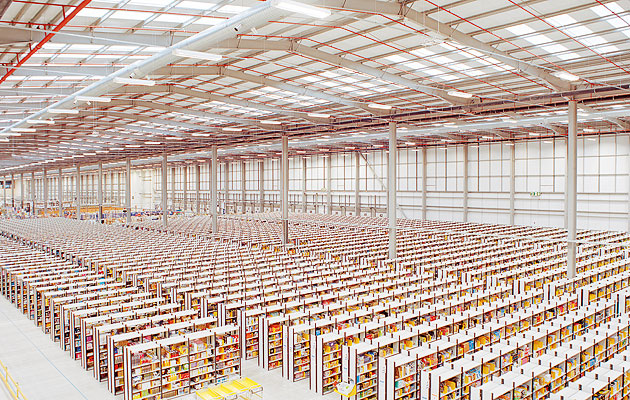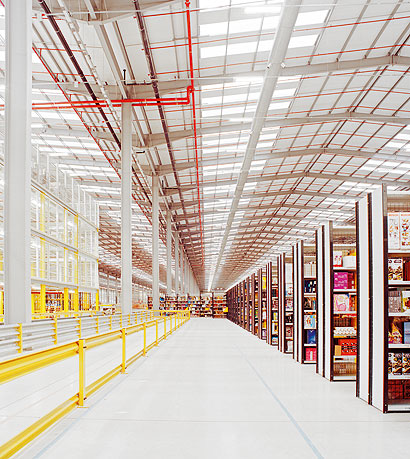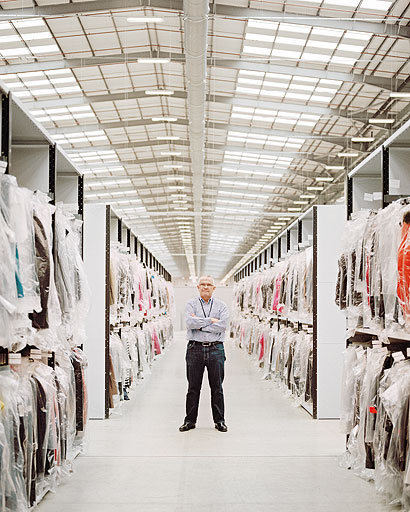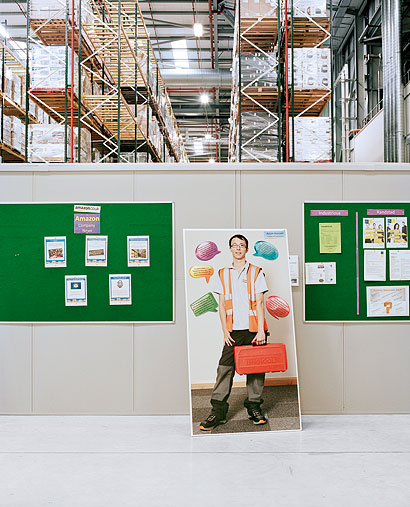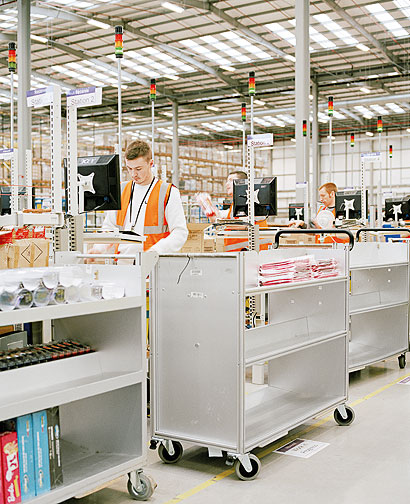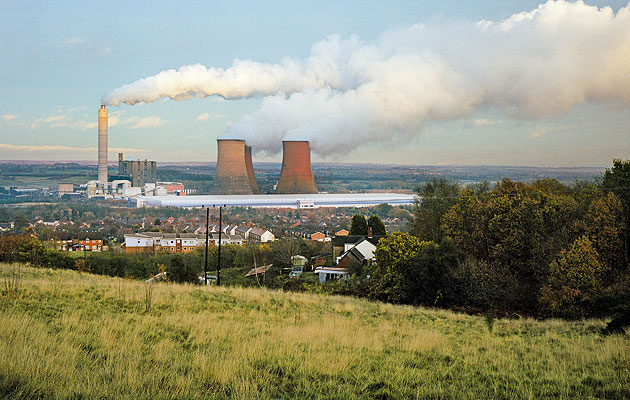|
Amazon’s huge warehouse in Rugeley, Staffordshire (image: Ben Roberts) |
||
|
The vast sheds of online retail are so complex that only robots can navigate them. But in this digitalised world, human workers too are increasingly being treated as machines In the centre of a vast distribution warehouse in Goldsboro, Pennsylvania, a 200,000sq ft area is marked out with bright yellow paint and warning signs. The space is filled with racks of shelving, each 6ft high and several feet square, packed with goods – in this case, nappies and other childcare items. But humans can’t enter this space to get to those goods: this is where the robots work. Within the robot zone, 260 bright orange, 800lb lozenges spin and lift, sliding under different shelving units and carrying them to the edges of the zone, where human pickers wait to add or remove packages. These are Kiva robots: warehouse automatons that trundle tirelessly around the merchandise, following computer-readable marks on the floor. Faster and more accurate than human handlers, they do the heavy lifting, allowing Quidsi, the owner of Diapers.com, to ship thousands of orders every day from this warehouse alone. Meanwhile in Rugeley in Staffordshire, inside a sky-blue warehouse the size of nine football pitches on the site of an old colliery, hundreds of people in orange tabards push trolleys down deep aisles of shelving, stacking them with books, DVDs, electronics and other goods. Each worker walks quickly, following the directions on a handheld device that pings constantly with new locations to be visited. It also tracks the worker’s progress, ensuring that they cover enough ground – up to 15 miles a day – and pick enough items to enable their employer, Amazon.com, to send out an average of one fully loaded truck from one of its eight UK facilities every three minutes. The pickers at Rugeley need the devices because they cannot navigate the space by themselves. Amazon warehouses use a system called “chaotic storage” which eschews traditional, human-oriented arrangements – books by author name over here, DVDs by title over there – for an apparently random distribution of objects across the entire warehouse, so boxes of Kindles sit alongside sporting equipment alongside stationery. This arrangement only appears random: it conforms not to human logic, but to machine logic, like bits of information on a hard drive. An automated storage and distribution programme constantly calculates the frequency of need and relationship between different items, in order to ensure the shortest and fastest paths between them for the trundling pickers. As a result, both the Amazon and the Quidsi warehouses are prime examples of what human geographers call code/spaces: physical and social spaces shaped as much by the computers that control them as by the people who build and use them. The effect of “coding” these spaces is multiple. For the operators, they permit a new kind of low-margin retail, with millions of different items stored under a single roof and available in a single shipment. For consumers, they offer lower prices and incredible convenience: huge ranges of goods, available at the click of a button on the home computer or smart phone, linked to a stored credit card and delivery address. Squeezed in the middle are those workers: constantly serving the Kiva bots, or following the relentless directions of handheld devices, with break times carefully monitored and little job security. The low pay and seasonal nature of shopping means staff turnover in distribution centres is high. With personal devices and robotic handling, the level of training for new staff is very low, allowing the businesses to hire agency and zero hour workers during peak times with little effect on productivity. (A Chartered Institute of Personnel and Development study in August revealed that more than a million British workers categorised as “full-time employees” are on zero-hours contracts, which do not guarantee any working hours or pay.) While not all goods are amenable to robotic handling, the effects of online optimisation are starting to be felt across other forms of retail. Tesco.com, the online shopping division of the UK’s largest supermarket, grew 10 per cent in 2012, even as the chain announced it was cutting back on new store openings. Instead, it is concentrating on developing “dark stores”: the fifth opened in Crawley in January. These stores, despite being laid out in the same way as normal stores, are not open to the public, but employ up to 300 staff each as “virtual shoppers”, picking items for online customers. Tesco came under fire in February when it was revealed that staff at its Dublin distribution centre were required to wear arm-mounted terminals that logged their performance, awarding points for the time it took to complete tasks. Each of the Motorola Wearable Terminals, whose manufacturer promises to deliver “maximum error proof productivity, operational efficiency and accuracy”, has a “break” function to allow the user to record toilet and other unscheduled breaks, with resulting drops in scores. One of the Dublin workers also claimed that the system allowed the centre to employ more workers with poor English, who could simply follow the instructions on the terminals.
The Rugeley warehouse is next to the local power station (image: Ben Roberts) All of this automation is part of an end-to-end optimisation of operations across local and global supply chains, from fast fashion to international cargo shipping, which extends from the 72-pixel icon on a smartphone screen, through telecommunication networks, warehouses and trucks, all the way to the fields and factories where goods are produced. The core characteristic of this process is to render the “real world” more machine-like: buildings become input/output devices for shipping goods, workers become processes under constant monitoring and modification, and consumer goods become data streams; uniquely identifiable bits in constant motion, built, routed, rerouted and delivered in response to real-time events across a global infrastructure. In the run-up to Hurricane Sandy, Walmart dedicated 50 staff at its Bentonville, Arkansas headquarters to a disaster-response programme which immediately began coordinating with meteorologists and predictive algorithms to send emergency supplies to stores ahead of the storm’s landfall, and backfilling distribution centres outside the storm zone for immediate delivery after the danger had passed. As one analyst noted, an earthquake in China is more likely to lead to empty shelves in US supermarkets than any domestic disaster. Not all businesses are so well distributed of course. The fuel protests of 2000, when hauliers and farmers, angered by the rising costs of petrol, blockaded fuel depots across the UK, caused hospitals to suspend operations, supermarkets to ration food and the postal service to stop deliveries. Then home secretary Jack Straw ordered the police to take a “robust approach” to protesters, and 1,000 army drivers were put on standby. One of the effects of optimisation, of rendering the world as if it were a digitally efficient space, is that it is also seen like a machine. Any disruption to the supply infrastructure is seen as a cost, so the threat of a dirty bomb in a major port and a peaceful protest on a power station are both viewed in the same way. In March 2012, Amazon acquired Kiva Systems, creator of both the eponymous robot and the software systems that operate them. Although they have yet to employ robots in any of their own warehouses, Amazon’s computational infrastructure is already so vast that for a number of years it has also been in the business of selling that infrastructure itself as a service, in the form of Amazon Web Services, a “cloud” of virtualised processing and data storage services used by many of the world’s largest applications and websites. One of the services Amazon offers in this way is Mechanical Turk, a tool for distributing large tasks that are hard for computers but easy for humans – such as transcription, proof-reading or image identification – to a crowd of unskilled workers, each undertaking tiny pieces of the task for a few pennies at a time. Like the pickers in Amazon’s warehouses, “Turkers”, as they’re known, are transformed into computerised processes, atomised labour waiting to be selected by the central algorithm. Even where optimisation has not filtered down to high streets and truly local shops, it is possible to automate one’s shopping with online tools. Taskrabbit in the US, and Taskpanda in the UK, are services for hiring local workers for small chores, such as putting up shelves, walking dogs or collecting groceries. Taskrabbit also offers “Taskrabbit for Business” for short- term workers – without insurance, minimum wage or any of the protections provided by employee labour laws. Whether you’re a Taskrabbit, a Turker or a tablet-guided picker, the atomisation of labour inherent in optimised systems keeps unions out and wages low, to the benefit of the consumer. Through the supply chain-driven optimisation of architecture, transport and human resources, all shopping is effectively becoming online shopping. The “cloud” of information services which is widely touted as the solution to all of our information needs is also an ideology that shapes virtual and physical retail, a promise of low-cost and near-instant consumerism that frees many of us up to work harder at our own labours, while alienating us not only from the source of our food and goods, but from the systems and processes that drive that consumption. Smartphone in hand, virtual wallet open, rushing from home to work and back again in order to sign for that delivery, we are as much subjects of the supply chain as the pickers in Amazon’s chaotic warehouses, or the personal shoppers in the grocers’ dark stores.
Pickers can walk up to 15 miles a day along the vast aisles (image: Ben Roberts)
Allan Lyall, vice president of European operations for Amazon (image: Ben Roberts)
Life-size portraits of staff by the noticeboards (image: Ben Roberts)
Workers scan every product arriving from around the world (image: Ben Roberts) |
Words James Bridle |
|
|
||
|
The warehouse and power station dominate view of Rugeley (image: Ben Roberts) |
||

